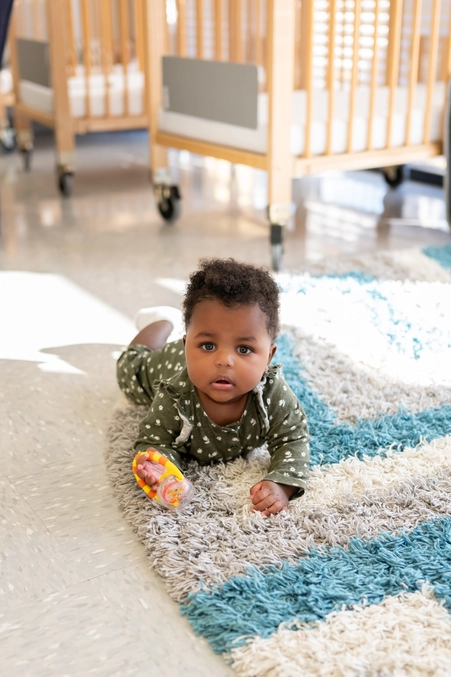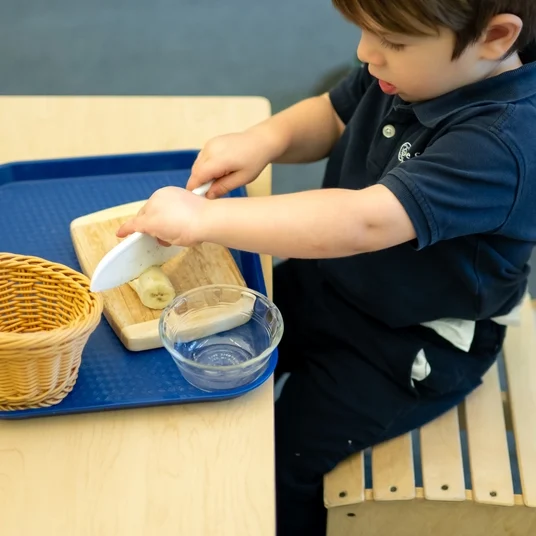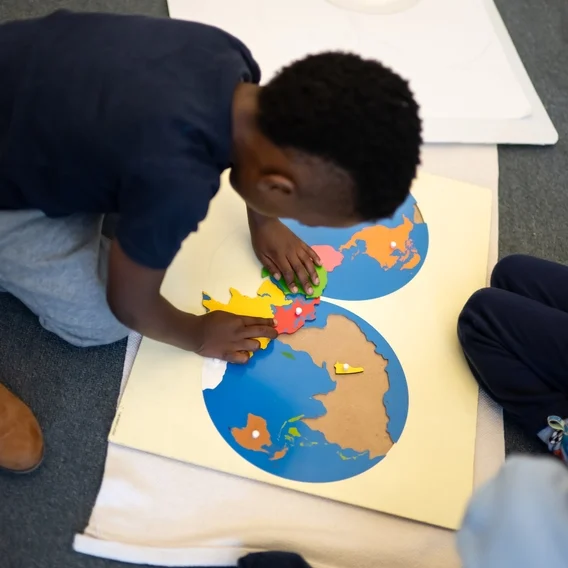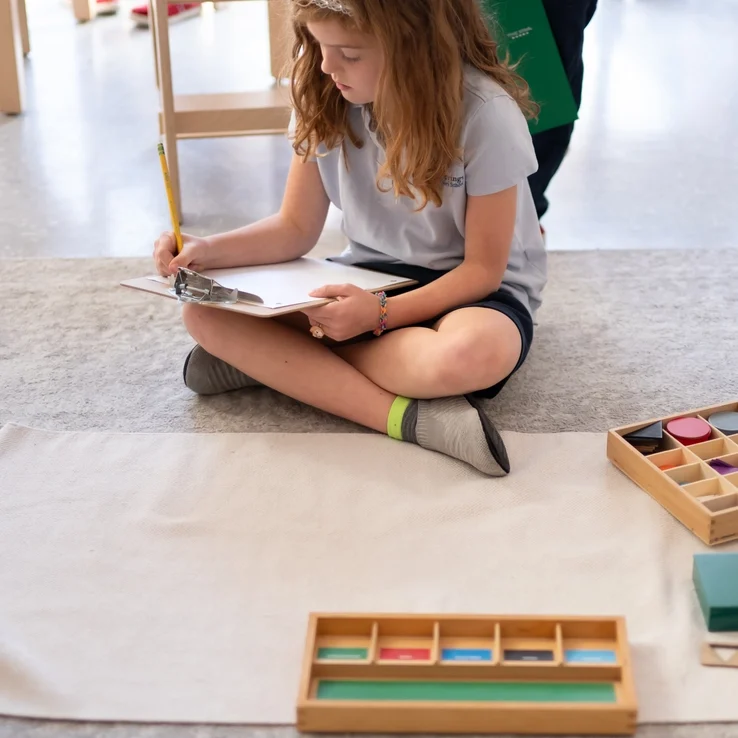Curriculum
INFANT HOUSE CURRICULUM
Routine is the basis of the Infant House curriculum. Having a rhythm that children follow every day gives them a sense of security and allows them the freedom to focus on other activities. Subject areas are integrated into the routine of the day. Expand the boxes below to read more about each subject.
Language
Teachers expose children to language as much as possible, by reading aloud during feeding, sportscasting, or narrating through everything, singing, and showing them picture cards.
Practical Life
Teachers support students in gaining independence and doing things for themselves, for example, feeding, using a fork, toilet use, opening and closing objects, sitting and sleeping independently.
Sensorial
The sensorial area will help children hit some major milestones and stimulate their senses, including sight, touch, hearing, smell, and taste. Some of the materials available in the classroom are object permanence boxes, and dowels and rings.
Gross Motor
In our Montessori Infant classroom, there are no restraining apparatuses (high chairs, exersaucers, or other immobilizing devices). Children are encouraged to have freedom of movement throughout the room and use their bodies to move furniture or push carts and do tummy time.

TODDLER HOUSE CURRICULUM

Practical Life
This area focuses on the toddler's ability to care for themselves and to become aware of and care for the environment around them. Students will learn concentration and order to gain independence through repetitive and precise exercises. Examples include feeding themselves, dressing and undressing, toilet learning, hand washing, drinking from a cup, scooping, pouring, grace and courtesy, etc.
Movement
Our Toddler classroom encourages the movement Toddlers so desperately crave while helping children learn control of the body and develop spatial awareness, balance, and strength. Movement activities include yoga, dance, climbing apparatuses, and indoor and outdoor play.
Language
Exposure to the elements of language is critical for this age group. Activities are designed to encourage expression, build vocabulary, strengthen word mapping skills, and promote linguistic understanding. Regular conversation is encouraged in addition to formal reading, singing, rhyming, etc.
Sensorial
Toddlers love nothing more than to explore, examine, and test. The sensorial materials encourage children to touch, watch, listen, taste, and smell while helping them discriminate, classify, assign vocabulary, and problem-solve.
Math
Teachers will introduce basic mathematical and scientific concepts to prepare children to move up to the Children's House classroom. Toddlers will explore the concept of quantitative description as well as the basis of experimentation and prediction.
Culture and Art
Toddlers explore the different celebrations and traditions of the cultures represented in their classroom. They begin to understand and become aware of the world outside of themselves. Art and music are significant components of the Toddler curriculum, with free expression and planned projects to foster creativity available daily.
CHILDREN'S HOUSE CURRICULUM
Practical Life
Practical Life activities are designed to help students learn to care for themselves, others, and their environment. Children develop concentration, motor skills, and a sense of community through tasks like pouring, dusting, and polishing. As they grow, they master essential life skills like sewing and shoe tying.
Sensorial
Sensorial materials help children refine their senses and classification skills. Through activities that engage smell, taste, touch, sight, and sound, they learn to differentiate concepts and develop spatial awareness, pattern recognition, and motor skills.
Language
Children learn about 14,000 words by age six, making the Montessori language section essential. Children progress toward independent reading in the Children’s House through phonetic instruction and hands-on activities.
Math
In the Children’s House, hands-on math activities give children a concrete understanding of quantity and operations. By Kindergarten, they often perform mental math, including carrying, borrowing, multiplication, division, and fractions. They also explore basic geometry and algebra concepts.
Science
Curiosity drives learning, and Montessori science activities nurture this through hands-on exploration. In the Children’s House, students explore magnetism, buoyancy, color mixing, zoology, botany, astronomy, and chemistry. They practice prediction, experimentation, measurement, and reporting while learning classification and proper terminology.
Geography and Culture
Montessori education fosters global awareness by exploring diverse cultures, traditions, and beliefs. In the Children’s House, students study the world, starting with the globe and moving locally. Families share their cultural traditions, and students celebrate holidays with food, dance, and customs, promoting appreciation of diversity and unity.
Creativity and Expression
Children’s House classrooms nurture creativity and self-expression through art, music, and movement. Activities like painting, molding, and coloring are always available, and traditional Montessori tasks often include creative elements. Students enjoy music through singing, dancing, and listening, while movement activities support balance, coordination, and body control.

ELEMENTARY HOUSE CURRICULUM

Geography
The Geography lessons explore political geography and matter, the relationship between the Sun and the Earth, mountains, and rivers, and how humans impact their world. Geography lessons introduce science experiments and demonstrations that trigger the child's imagination to apply concepts to a larger scale.
Mathematics
Mathematics is introduced with concrete materials that isolate a particular concept. The children move through exercises with these materials until they reach abstraction and work completely on paper. Their work includes fractions, long multiplication, division, decimals, word problems, beginning algebra, and more advanced topics like square roots and cube numbers.
Geometry
Elementary students explore measuring the world through explorations with various shapes that lead to work in area and volume.
Language
The child in the Elementary House is ready to delve into the nuances of the English language. They explore the history of the language, how each piece of it functions today, and different ways to interpret written words. The child continues to perfect their skills in reading and writing.
Biology
Elementary-age children are incredibly interested in the plants and animals around them. The Biology lessons aid the child in organizing plants and animals into categories by their characteristics. Lessons in Biology also help elementary children understand the interconnectedness of life on Earth and prepare them for chemistry in the future.
History
From our beginnings to the present day, Elementary children love to hear stories of the past. The teacher encourages this love by becoming a storyteller of the past and encouraging the children to further explore by researching topics of interest in books. Many children develop timelines of historical events or write short books to show classmates what they have learned.
Art
Art is another form of self-expression for children. Elementary art builds on the foundations of primary art and sensorial art by introducing different media, visual concepts like balance and symmetry, and historical art forms from cave paintings to modern art. The Elementary environment allows children time to explore art and refine their abilities.
Music
Music changes from a sensorial experience to a true study in the Elementary House. Children can learn to read and write music using treble, bass clefs, and standard music notation. They can also play several rhythm instruments, alone and in groups, and listen to music worldwide.
